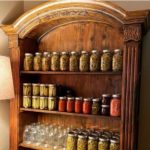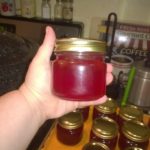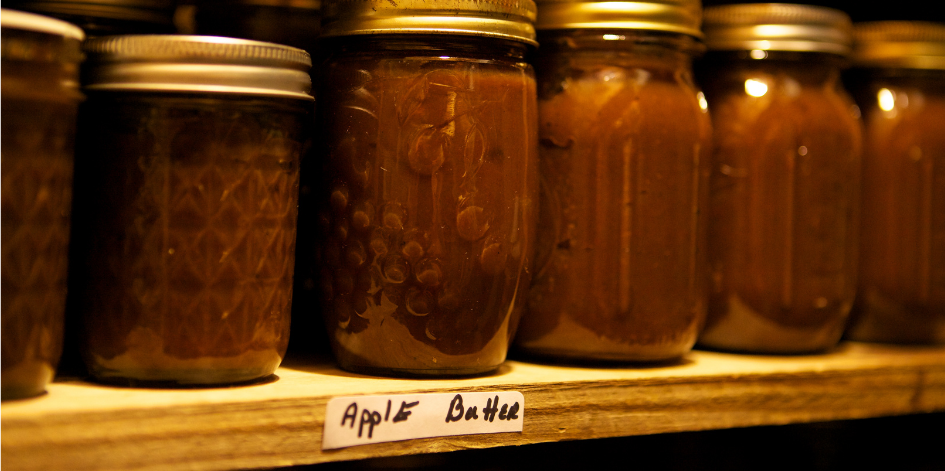I am reading in bed one night when my phone buzzes from my nightstand, and I glance over and see a new text message from my sister-in-law. The message contains a picture of a beautifully ornate bookshelf, but instead of books, rows and rows of mason jars filled with that season’s harvest of green beans, pickles, and tomatoes adorn the shelves. The accompanying text is simple. It reads, “pretty means different things to different people.”
 As I take in rows of colorful jars ornately decorating this bookshelf, I wholeheartedly agree. They are gorgeous and as significant as any piece of art. I zoom in on the picture to better see what was gathered and preserved when I think back to my grandmother’s house and the space she created to house all of the fruits of her gains from that season’s harvest.
As I take in rows of colorful jars ornately decorating this bookshelf, I wholeheartedly agree. They are gorgeous and as significant as any piece of art. I zoom in on the picture to better see what was gathered and preserved when I think back to my grandmother’s house and the space she created to house all of the fruits of her gains from that season’s harvest.
The Art of Canning
Canning is an art form with that year’s harvest serving as its medium. Anyone who has walked through a kitchen to view the sunlight reflecting off a dozen freshly sealed mason jars and witnessed their colors bouncing off the countertops can attest to this. As a child, I sat and watched as my grandmother, who we all called Mimi, systematically prepared the jars, fruits, and vegetables, humming while she worked. Canning brings with it a certain rhythm, a cadence all its own. My mother also carries the talent for growing and preserving as well. As an avid gardener, our conversations often involve planting specifics, how many rows of okra managed to avoid hungry deer, and the degree to which the heat destroyed the beans.
I sat down with her recently to talk about gardening and canning, a skill that becomes part of a family’s heritage when passed from generation to generation.
Here is what she shared:
PPT: What made you want to learn how to preserve and can?
Mom: Well, when I would visit Mimi, she would can tomatoes, and I would help. One day I told her I wanted to learn, and she bought me my first pressure canner.
PPT: It’s quite a bit of work! Why do you love it? What makes it worth the effort?
Mom: It is a ton of work! I can because I know what the jars hold. The jars do not contain any manufactured preservatives. You can see everything inside, and you have the pleasure of enjoying the delicious natural food that you grew and harvested yourself. There is such joy in that. The hardest part of the process is readying your produce. The process itself is not that difficult at all. It has become a lost art up until recently, but more and more, I am noticing people developing the desire to learn the craft.
PPT: Do you have a favorite memory of canning with Mimi?
Mom: I loved putting up green beans and tomatoes with her. Also, we would make pear and fig preserves together. My job was to heat and slip the skins off the tomatoes and put them in a big bowl while she put them in the jars and into the canner. Not to mention that we would sit and snap all the green beans together. When we made the pear preserves, I would peel all the pears. My favorite part of that process was my time with my mom around her kitchen table. She would tell the best stories. Sometimes Nanny, her mother who lived next door, would come over to sit down for a visit while we worked.
PPT: I remember listening to those stories at the other end of the table. I remember the laughter. I know that you love to teach others to can as well. I know you taught our cousin Carla, who recently passed away, to can as well. She was so excited to learn from you. What do you remember about teaching her?
 Mom: Carla loved to cook and bake, and when she came over one day while I was making jelly. She sat and watched me and made mention of wanting to learn. I told her that I would teach her if she brought jars over. So, a few weeks later, Carla showed up with a box full of mason jars, and we worked through the process. She shared her jelly with everyone at work, so much so that she didn’t have much left. But that was Carla, very kind and generous. She had to make a batch of her own after that, which she did, and then proudly sent me a picture.
Mom: Carla loved to cook and bake, and when she came over one day while I was making jelly. She sat and watched me and made mention of wanting to learn. I told her that I would teach her if she brought jars over. So, a few weeks later, Carla showed up with a box full of mason jars, and we worked through the process. She shared her jelly with everyone at work, so much so that she didn’t have much left. But that was Carla, very kind and generous. She had to make a batch of her own after that, which she did, and then proudly sent me a picture.
PPT: I love that there indeed does seem to be a resurgence in learning the techniques of preserving. A few years back, everyone was baking homemade bread too. I know the return to these lost arts must make you smile.
Mom: It does. Decades ago, all the women in large families would gather to preserve the harvests from that year. They sat and told stories and taught the younger ones. Family and community were the most important things, and I hope that is all coming back.

